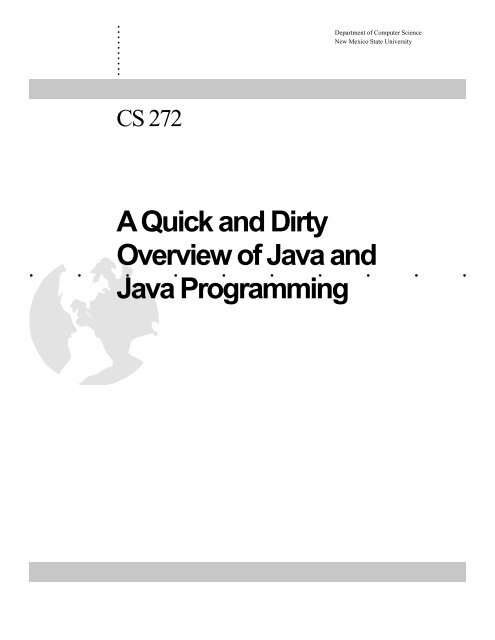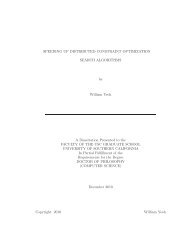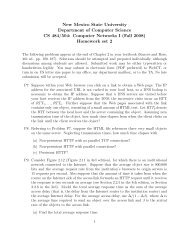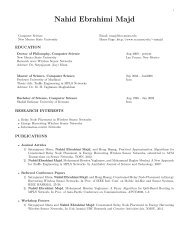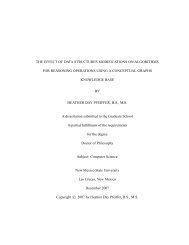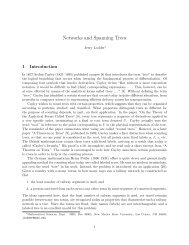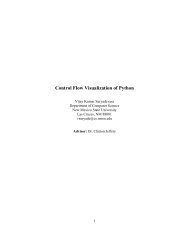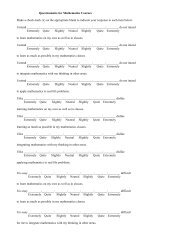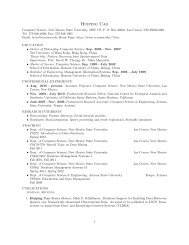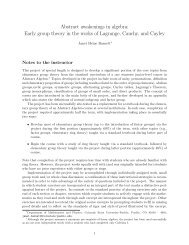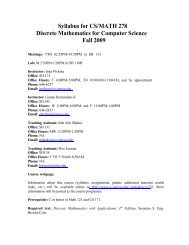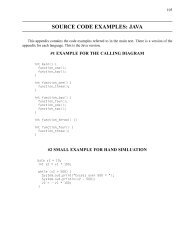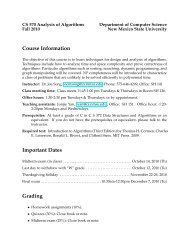A Quick and Dirty Overview of Java and Java Programming
A Quick and Dirty Overview of Java and Java Programming
A Quick and Dirty Overview of Java and Java Programming
Create successful ePaper yourself
Turn your PDF publications into a flip-book with our unique Google optimized e-Paper software.
Department <strong>of</strong> Computer ScienceNew Mexico State University.CS 272A <strong>Quick</strong> <strong>and</strong> <strong>Dirty</strong><strong>Overview</strong> <strong>of</strong> <strong>Java</strong> <strong>and</strong>. . . . . . . . . .<strong>Java</strong> <strong>Programming</strong>
.IntroductionObjectivesIn this document we will provide a very brief overview <strong>of</strong> the main concepts <strong>of</strong> the <strong>Java</strong>programming language, along with a number <strong>of</strong> examples.The purpose <strong>of</strong> the document is not to teach <strong>Java</strong>, but to allow someone who has alreadylearned <strong>Java</strong> before to review some <strong>of</strong> the basic concepts. The students are encouraged to typethe various sample programs <strong>and</strong> ensure that they work properly.Compiling <strong>and</strong> Running <strong>Java</strong> ProgramsBefore we start with our overview <strong>of</strong> the basic concepts <strong>of</strong> <strong>Java</strong>, let us recall the basicmechanisms that are employed to execute <strong>Java</strong> programs.The assumption is that you are currently using a st<strong>and</strong>ard SDK installation <strong>of</strong> <strong>Java</strong> in a Linuxtypeenvironment. If you are using a different environment (e.g., under Windows), some <strong>of</strong>this might not apply.<strong>Java</strong> is a compiled language. This means that, in order to execute a program, you will firstneed to go through a translation process (compilation). The compilation process is aimed attranslating the <strong>Java</strong> source program into another equivalent program written in a lower levellanguage. In the case <strong>of</strong> <strong>Java</strong>, the lower level code is expressed in a language called <strong>Java</strong>Virtual Machine code (JVM code). This code is then executed by a piece <strong>of</strong> s<strong>of</strong>tware, calledthe <strong>Java</strong> Virtual Machine (JVM). The JVM executes one instruction at a time from its inputprogram. This process is illustrated in the figure below.2
<strong>Java</strong>SourceProgram<strong>Java</strong>CompilerJVMProgram<strong>Java</strong>VirtualMachineThese two steps (compilation <strong>and</strong> execution) have to be explicitly requested by issuingappropriate comm<strong>and</strong>s in a terminal window.The compilation is requested by using the comm<strong>and</strong> javac which requests the execution <strong>of</strong>the java compiler. The comm<strong>and</strong> requests one input, which is the name <strong>of</strong> a file that containsa <strong>Java</strong> source program. By default, we expect these files to be named with an extension ‘.java’(e.g., FirstProgram.java). The typical compilation comm<strong>and</strong> line is:javac FirstProgram.javaIf there are some syntax errors in your program, the compiler will return a list <strong>of</strong> them, <strong>and</strong>you will have to fix them <strong>and</strong> recompile the program. If there are no errors, the compiler willcreate a new file which contains the result <strong>of</strong> the translation (a program expressed in JVMcode). The resulting file typically has the same name with the exception <strong>of</strong> the extensions,which is ‘.class’ (e.g., FirstProgram.class).At this point you are ready to execute the program. To accomplish that you will need to startthe <strong>Java</strong> Virtual Machine <strong>and</strong> feed the JVM code as input to it. The <strong>Java</strong> Virtual Machine isjust another program, that can be executed by specifying its name. The name <strong>of</strong> the JVM issimply java. Thus, if we request the execution <strong>of</strong> the comm<strong>and</strong> java <strong>and</strong> we provide asparameter the name <strong>of</strong> a file that contain JVM code, we will accomplish the goal <strong>of</strong> executingsuch JVM code. In our example, the comm<strong>and</strong> line to be used is:java FirstProgramAs you can see, when we provide the input to the JVM, we do not need to specify the ‘.class’extension in the file name (this is automatically added by the JVM when it accesses the file).3
.Basic Types, Expressions,<strong>and</strong> Control StructuresA Sample <strong>Java</strong> ProgramLet us start by showing a sample <strong>Java</strong> program, that we will then modify to illustrate thevarious concepts presented.// A very silly program that does almost nothingclass FirstProgram{// this is the main part <strong>of</strong> the programpublic static void main(String args[]){int x,y,z;x = 6;y = 2;z = x+y;System.out.println(“The result <strong>of</strong> “,x”+”+y” is “+z);} // end <strong>of</strong> main} // end <strong>of</strong> classEach program we will write will be composed <strong>of</strong> classes. We will extensively talk aboutclasses later in the course, but for the moment you can think <strong>of</strong> a class as a container whichencloses all the various functions <strong>and</strong> data that you will use in your program. In our example,the container (called FirstProgram) contains only one method – the main method. Everyprogram has to contain exactly one method called main. This method will be automaticallyexecuted when you start your program – thus, the main method represents the point where theexecution <strong>of</strong> your program is supposed to start.4
Every method is structured in two parts. The first part, called the Header <strong>of</strong> the method, is asingle line that essentially describes how the method is supposed to be used. The format <strong>of</strong> theHeader is:ReturnType Name <strong>of</strong> Method ( Comma-separated List <strong>of</strong> Parameters )The Name <strong>of</strong> Method indicates what name we are giving to the method; this name will beused to identify the method when we request its execution. The only exception is the methodcalled main: we never explicitly request its execution, its execution starts automatically whenwe initiate executing the program.The Parameters represent the inputs that we wish to provide to the method; the Return Typedescribes what type <strong>of</strong> result the method will produce upon execution. For simplicity, you canthink <strong>of</strong> a method as a black box, that takes a number <strong>of</strong> inputs (the parameters) <strong>and</strong> producesone result (<strong>and</strong> Return Type is telling us what is the type <strong>of</strong> the result).ParametersResultThe second part <strong>of</strong> a method is called the Body <strong>of</strong> the method; the body is enclosed betweenbraces (‘{‘ <strong>and</strong> ‘}’) <strong>and</strong> it is itself organized in two parts. The first part is a collection <strong>of</strong>declarations, typically used to describe what variables are going to be employed in themethod, <strong>and</strong> a collection <strong>of</strong> statements. The statements are the actual instructions that describewhat steps should be taken to perform the action that the method is supposed to perform. Ifwe take the above example, we obtain the situation illustrated in the following figure.5
.public static void main(String args[])DeclarationsStatements{int x,y,z;x = 6;y = 2;z = x+y;System.out.println(“The result <strong>of</strong> “,x”+”+y” is “+z);} // end <strong>of</strong> mainMethod BodyMethod HeaderVariablesAll the data used by a program have to be available in memory in order to be used. The dataare stored in containers called variables. Each variable can store one entity (we will call themobjects, although this term will be refined in the successive sections). Each variable, in orderto exist, has to be Declared in the declaration section <strong>of</strong> a method. We can have also variablesdeclared outside <strong>of</strong> the methods, but we will deal with these later on.Every variable in the program has five attributes that describe its properties:1. name: this is the name that is used to refer to the variable;2. type: this information describes what kind <strong>of</strong> values we will be allowed to place inthe variable <strong>and</strong> what type <strong>of</strong> operations we will be able to perform;3. value: this is the current content <strong>of</strong> the variable; at any point in time, the variable hasexactly one value;4. scope: this is the part <strong>of</strong> the program where a variable can be used. In <strong>Java</strong> we havetwo types <strong>of</strong> scopes:a. Local: the variable is declared inside a method; in this case the variable canbe used exclusive within that method;b. Global: the variable is declared inside the class but outside <strong>of</strong> any specificmethod; in this case, each method in the class can make use <strong>of</strong> suchvariable.6
5. lifetime: this is the period <strong>of</strong> time between the creation <strong>of</strong> the variable <strong>and</strong> itsdestruction. We typically distinguish between Static variables – created when theprogram is started <strong>and</strong> destroyed only when the whole program is finished – <strong>and</strong>Dynamic variables – created during the execution <strong>of</strong> the program, <strong>and</strong> possiblydestroyed before the end <strong>of</strong> the program.Let’s see some examples:• A typical declaration <strong>of</strong> a variable isint x;which declares a variable named x <strong>and</strong> <strong>of</strong> type int (i.e., it will store an integernumber). By default, the initial value <strong>of</strong> the variable is zero. If we want to have adifferent initial value we can explicitly indicate it:int x = 6;• if the variable is declared inside a method, e.g.,int mymethod ( ){}int x = 6;....then the variable has a scope limited to the method called mymethod – it can be usedonly inside this method <strong>and</strong> nowhere else. If instead we declare the variable outside<strong>of</strong> the method, e.g.,class FirstProgram{}int x = 6;...then the scope <strong>of</strong> the variable x is the entire class called FirstProgram; this meansthat any method inside that class will be able to access <strong>and</strong> use the variable x.• A variable that is local to a method, has a lifetime that corresponds to the lifetime <strong>of</strong>the method. This means that the variable is created exclusively when the method is7
.started, <strong>and</strong> it will be destroyed once the method is finished. Consider the followingsimple example:class FirstProgram{public static void main (String args[ ]){}....PrintResult();....}public static int PrintResult(){}int x = 6;...In this case, the variable x belongs to the method PrintResult; it will be created onlywhen the method is called (e.g., when the call to PrintResult is performed inside themain) <strong>and</strong> it will be destroyed once the method PrintResult is left.• On the other h<strong>and</strong>, a variable that is declared within the class will be immediatelycreated when the class is activated (e.g., when we start executing the program, if theclass contains the main method).Primitive TypesEach data item in the program has a type. The type defines what are the possible values thatthe item can assume as well as it indicates what operations we can apply to such item. Thus, atype is always composed <strong>of</strong> these two components:• a Domain: the set <strong>of</strong> values that belong to the type• a collection <strong>of</strong> operations that we can apply to objects <strong>of</strong> the type.8
In this section we will focus on a class <strong>of</strong> types called Primitive Types. These are built-in datatypes <strong>of</strong> the language. They are characterized by the fact that the domains <strong>of</strong> these data typescontain Atomic values – i.e., the values are treated as atomic entities (<strong>and</strong> they are never“decomposed” into components).These can be classified into four groups: Boolean types, character types, integer types, <strong>and</strong>floating point types.Boolean Types<strong>Java</strong> provides only a single Boolean type, called boolean. The domain <strong>of</strong> this data typecontains only two values, denoted true <strong>and</strong> false. The operations allowed on objects <strong>of</strong> thistype correspond to the traditional operations on Boolean values, e.g., logical <strong>and</strong>, logical or,negation, etc. These are denoted by the symbols && (logical <strong>and</strong>), || (logical or), <strong>and</strong> !(negation). For example, the Boolean formula a <strong>and</strong> (b or not c) is represented in <strong>Java</strong> asa && ( b || (! c))Character Types<strong>Java</strong> provides a single type to represent characters, called char. The domain <strong>of</strong> this data typeis the set <strong>of</strong> all characters belonging to the Unicode st<strong>and</strong>ard. In particular, the ASCIIcharacter set is a strict subset <strong>of</strong> the Unicode st<strong>and</strong>ard. Character constants can be representedin two different ways:• using the symbol representing the character, enclosed between single quotes; e.g., thecharacter a is represented as ‘a’• using the numeric code associated to the character by the Unicode st<strong>and</strong>ard. Forexample, the character ‘a’ is represented by the numeric code 97.The two notations are interchangeable. For example, the following assignments are both valid<strong>and</strong> accomplish the same effect:char x = ‘a’;char x = 97;For the moment, the only immediate operations on characters that we will consider are thest<strong>and</strong>ard operations on arithmetic types (increments <strong>and</strong> decrements). For example, if we wantto print all the alphabetic characters we can write:a=97;for (int i = 0; i
.• byte: it is stored in 8 bits <strong>and</strong> has a domain including all the integers from -128to +127• short: it is stored in 16 bits <strong>and</strong> represents integers in the range -32,768 to+32,767• int: it is stored in 32 bits <strong>and</strong> represents the integers in the range -2,147,483,648to +2,147,483,647• long: it is stored in 64 bits <strong>and</strong> represents integers in the range-9,223,372,036,854,775,808 to +9,223,372,036,854,775,807The operations allowed are the traditional arithmetic operations (addition, multiplication,etc.). It is important to observe that by default all the operations between integers returnintegers as result. Thus, the expression 5/2 returns the value 2.Floating Point Types<strong>Java</strong> <strong>of</strong>fers a number <strong>of</strong> data types that allow to store non-integer numbers. The types differ inthe amount <strong>of</strong> memory employed – leading to a different level <strong>of</strong> precision (i.e., number <strong>of</strong>digits that can be stored). <strong>Java</strong> <strong>of</strong>fers the following types:• float: 32 bits• double: 64 bitsThe operations allowed are the usual arithmetic operations. Observe that these are operationsbetween floating point numbers, that produce floating point numbers as result. In this case, theresult <strong>of</strong> the expression 5.0 / 2.0 is 2.5.ExpressionsThe simplest type <strong>of</strong> expressions that one can build are expressions composed <strong>of</strong> a singlevalue (constants). A numeric constant is expressed using the traditional notation. Integernumbers should be written without leading zeros (a number with a leading zero isautomatically assumed to be in octal form, while a number that starts with 0x is assumed to bein hexadecimal format). Floating point constants can be expressed either in the traditionalfloating point format, e.g., 12.352, or using scientific notation, e.g., 1.232e+3 (which means1.232x10 3 ).Character constants are expressed either using the symbolic notation <strong>and</strong> the single quotes,e.g., ‘X’ or ‘b’, or using the numeric notation based on Unicode. Special symbols are used torepresent certain unprintable characters, such as the newline character (‘\n’), the tabulationcharacter (‘\t’), the single quote character (‘\’’).More complex expressions are built using constants, variables, <strong>and</strong> operators. The simplesttype <strong>of</strong> operator employed is the assignment operator, which allows to store the result <strong>of</strong> anexpression in a variable. The syntax <strong>of</strong> an assignment is10
variable name = expressionThe expression is expected to produce a value <strong>of</strong> the same type as the variable. If this is notthe case, then a type conversion process is applied, to change the value <strong>of</strong> the expression sothat it has the same type as the variable. Observe that an assignment statement is itself anexpression, which returns as result the same value that is stored in the variable. This allows usto write things like:which stores 6 in a <strong>and</strong> 8 in b.b = (a = 6) + 2;More complex expressions can be obtained by using operations allowed by the types <strong>of</strong> thedata used in the expression; for example,a + (b*3-c)/dThe order <strong>of</strong> execution <strong>of</strong> the operations is determined by the following rules:• parenthesis: expressions within parenthesis are evaluated first• precedence: in absence <strong>of</strong> parenthesis, operators with highest precedence are appliedfirst. For examplec+e*dthe produce e*d is done first, followed by the addition.• associativity: when we have multiple operations with the same precedence level, theassociativity rules determine in what order they should be executed. Most operations(e.g., +, *, -, /) are left-associative, which means that they are executed from left toright. There are some operators that are right-associative, i.e., they are executed fromright to left. A typical example <strong>of</strong> a right-associative operator is the assignmentoperator =; thus, the expressionis evaluated from right to left:a = b = c = 6a = ( b = ( c = 6) )Relational Operators<strong>Java</strong> provides a number <strong>of</strong> relational operators, i.e., operators that are used to performcomparison between results <strong>of</strong> expressions. These operators compare two values <strong>and</strong> producea value <strong>of</strong> type Boolean as result. The traditional relational operators are:• == used to compare for equality• != used to compare for not-equality11
.• > used to test for greater-than• < used to test for less-than• >= used to compare for greater-or-equal-than•
StatementsThe body <strong>of</strong> a method contains a collection <strong>of</strong> statements, used to describe the steps requiredto implement the functionality <strong>of</strong> the method. <strong>Java</strong>, as most programming languages, providesdifferent types <strong>of</strong> statements. We classify statements into two main classes:1. elementary statements2. complex statementsComplex statements are built by assembling together other statements <strong>and</strong> executing themaccording to a predefined ordering.Elementary StatementsIn <strong>Java</strong> we have two forms <strong>of</strong> elementary statements:• assignments• method invocationsWe have already seen examples <strong>of</strong> assignment statements. A method invocation requests theexecution <strong>of</strong> a method. The typical format (for the moment…) <strong>of</strong> a method call ismethod name ( parameter values )which requests the execution <strong>of</strong> the method called method name, providing the inputsspecified by the parameter values list. We will come back to methods in the next section.Complex StatementsA complex statement is obtained by combining together, according to one <strong>of</strong> some possiblestrategies, other statements (themselves either elementary or complex). <strong>Java</strong> provides threetype <strong>of</strong> strategies for building complex statements: sequencing, conditional, <strong>and</strong> iteration.SequencingA sequencing statement is used to specify the fact that a certain set <strong>of</strong> statements has to beexecuted, one at a time, in the order they are written. In <strong>Java</strong>, sequencing is expressed bysimply writing down the statements in the order they are meant to be executed, separated by‘;’ <strong>and</strong> enclosed within braces.For example{a = 6;b = 8;c = a*b;}is a sequencing <strong>of</strong> three (elementary) statements. This construction is also frequently knownas a block. If one desire, it is possible to insert declaration <strong>of</strong> variables at the beginning <strong>of</strong> ablock; these variables will have a scope limited to the block <strong>and</strong> will be destroyed as soon asthe block execution is completed. For example:13
.{int x;x = 2*a;y = x + 5;}the variable x is local to the block <strong>and</strong> will be destroyed once the execution <strong>of</strong> the block isfinished. Observe that a block is viewed by <strong>Java</strong> as a single (complex) statement. Thus, wecould easily write things like{a = 6;{b = 8;c = a*b;}a = a+ b+c;}which is a block that contains 3 statements (the first <strong>and</strong> last are elementary, the second is acomplex statement).ConditionalsThis conditional construction allows us to combine statements with conditions, whereconditions are used to decide whether the statement should be executed or not. There are twotypes 1 <strong>of</strong> conditionals:<strong>and</strong>if (condition)statementif (condition)statementelsestatement1 There is actually another type <strong>of</strong> conditional (the switch statement), but we will ignore it for themoment.14
In the first case (one-way condition), the specified statement will be executed only if thecondition is true; in the second case (two-way condition), the condition is used to decidewhich <strong>of</strong> two statements to execute (the first if the condition is true, the second if false).The conditions can be any expression that produces a result <strong>of</strong> type boolean.The following are examples <strong>of</strong> conditional statements• a simple one way conditionif (max < value){}max = value;count++;Note that in this case the statement that is selected by the condition is a complexstatement (a block).• a two-way conditionalif (x > y)else{}y = x;x++;y = y –x;• a nested conditional:if (x > y)if (z > y)min = y;Note that in this case the statement selected by the condition (x > y) is itself aconditional statement.15
.IterativeThe iteration is used to describe the fact that a statement should be repeated a certain number<strong>of</strong> times. We will use three forms <strong>of</strong> iteration.while-loopsThe format <strong>of</strong> this construction iswhile (condition)statementwhich requests the statement to be repeated as long as the condition is true. The condition istested before each execution <strong>of</strong> the statement, <strong>and</strong> the statement is performed only if thecondition evaluates to true.For examplex = 10;while ( x > 1)x = x / 2;do-while-loopsA different construction is represented by the do-while iteration; in this case, the condition <strong>of</strong>the loop is tested not before each execution <strong>of</strong> the statement, but after each execution. Thestructure isdoFor example,statementwhile (condition);do{}x = x-1;y = y * a;while (x > 0);for-loopsThis structure is typically used to repeat the execution <strong>of</strong> a statement for a known number <strong>of</strong>times. The structure is16
for ( initialization ; condition ; increment )statementThe initialization <strong>and</strong> increment can be arbitrary elementary statements (or even sequences <strong>of</strong>statements separated by commas), while the condition can be any expression <strong>of</strong> type Boolean.The actual meaning <strong>of</strong> this construction can be understood by observing that it is equivalent tothe construction:initialization;while (condition){}statement;increment;For example, if we want to repeat a statement 10 times, we can write:for (i = 0; i < 10; i++)statementInput <strong>and</strong> OutputIn order to be able to write some simple programs, we need to know how to perform basicoperations <strong>of</strong> input <strong>and</strong> output. In particular, we would like to be able to read data from thekeyboard (<strong>and</strong> store them into variables) <strong>and</strong> to write things on the screen. Here we will seejust some basic mechanisms to perform these operations. More sophisticated solutions toinput <strong>and</strong> output will be discussed later in the course.Output<strong>Java</strong> provides some methods for printing things on the screen. The two methods we willfrequently use are called print <strong>and</strong> println <strong>and</strong> they are present in the class System.out. Inorder to be able to use them, you will need to remember to add at the top <strong>of</strong> the program thelineimport java.io.*;Both methods require a single argument, which is the string that should be printed on thescreen. The string can be a simple sequence <strong>of</strong> characters to be copied on the screen, as in thecaseSystem.out.println (“hello world”)17
.(everything within the double quotes is copied on the screen), or it can be a complex stringbuilt by concatenating different strings <strong>and</strong> values together (using the ‘+’ operation toconcatenate strings); for example:System.out.println(“the sum <strong>of</strong> “+a+” <strong>and</strong> “+b+” is “+(a+b));The difference between print <strong>and</strong> println is that the second will also move the cursor to thebeginning <strong>of</strong> the next line.InputInput relies on the use <strong>of</strong> an object called System.in. System.in represents the input part <strong>of</strong> theconsole window. A simple way <strong>of</strong> reading input is to create a special object <strong>of</strong> type Scanner.The class Scanner is defined in java.util.Scanner, which will have to be imported in order touse these features, i.e.,import java.util.Scanner;To create an instance <strong>of</strong> Scanner, connected to the st<strong>and</strong>ard input, we can write the expressionScanner input = new Scanner(System.in);The effect is to declare a variable (input) which contains a new instance <strong>of</strong> Scanner; theparameter given to the constructor indicates that this input scanner is connected to the consoleinput. The Scanner class has a number <strong>of</strong> methods to read the input stream.The Scanner class reads the input stream <strong>and</strong> divides it into tokens, which are contiguousstrings <strong>of</strong> characters separated by delimiters, which are special separating characters (e.g.,blank spaces, tabs, newlines). Tokens can either be read as strings or they can be converted toa base type, if the token is in the right syntax.Specifically, the Scanner class includes the following methods for dealing with tokens:• hasNext(): which returns true if <strong>and</strong> only if there is another token in theinput stream;• next(): which returns the next token string in the input stream; it generatesan error if there are more tokens left;• hasNextBoolean(): which returns true if <strong>and</strong> only if there is another token inthe input stream which can be interpreted as a boolean value;• hasNextByte(): which returns true if <strong>and</strong> only if there is another token in theinput stream which can be interpreted as a byte value;• hasNextShort(): which returns true if <strong>and</strong> only if there is another token inthe input stream which can be interpreted as a short integer (Short) value;• hasNextInt(): which returns true if <strong>and</strong> only if there is another token in theinput stream which can be interpreted as an integer (Int) value;18
• hasNextLong(): which returns true if <strong>and</strong> only if there is another token inthe input stream which can be interpreted as a long integer (Long) value;• hasNextFloat(): which returns true if <strong>and</strong> only if there is another token inthe input stream which can be interpreted as a floating point (Float) value;• hasNextDouble(): which returns true if <strong>and</strong> only if there is another token inthe input stream which can be interpreted as a double floating point(Double) value;• nextBoolean(): which returns the next token in the input stream if it can beinterpreted as a boolean value, issues an error otherwise (i.e., if there are nomore tokens, or the syntax <strong>of</strong> the token is not that <strong>of</strong> a boolean value);• nextByte(): which returns the next token in the input stream if it can beinterpreted as a byte value, issues an error otherwise (i.e., if there are nomore tokens, or the syntax <strong>of</strong> the token is not that <strong>of</strong> a byte value);• nextShort(): which returns the next token in the input stream if it can beinterpreted as a short integer value, issues an error otherwise (i.e., if thereare no more tokens, or the syntax <strong>of</strong> the token is not that <strong>of</strong> a short value);• nextInt(): which returns the next token in the input stream if it can beinterpreted as an integer value, issues an error otherwise (i.e., if there are nomore tokens, or the syntax <strong>of</strong> the token is not that <strong>of</strong> an integer value);• nextLong(): which returns the next token in the input stream if it can beinterpreted as a long integer value, issues an error otherwise (i.e., if thereare no more tokens, or the syntax <strong>of</strong> the token is not that <strong>of</strong> a long integervalue);• nextFloat(): which returns the next token in the input stream if it can beinterpreted as a floating point (Float) value, issues an error otherwise (i.e., ifthere are no more tokens, or the syntax <strong>of</strong> the token is not that <strong>of</strong> a floatingpoint value);• nextDouble(): which returns the next token in the input stream if it can beinterpreted as a double floating point value, issues an error otherwise (i.e., ifthere are no more tokens, or the syntax <strong>of</strong> the token is not that <strong>of</strong> a doublefloating point value).Additionally, Scanner provides methods to read a whole input line by line (one line at a time):• hasNextLine(): which returns true if <strong>and</strong> only if the input stream containsanother line <strong>of</strong> text;• nextLine(): it returns the current line <strong>of</strong> input (as string) <strong>and</strong> moves to thenext line.19
** @author Enrico Pontelli**/public class gradeStatistics{public static void main(String args[]){// create the Scanner objectScanner input = new Scanner(System.in);// counters for passes <strong>and</strong> failuresint passes=0, failures=0;// count number <strong>of</strong> studentsint numStudents=0;// used for inputint inputValue;do{System.out.print(“Result for next student (1=pass, 2=fail, -1=stop): “);inputValue = input.nextInt();if (inputValue == 1){passes++;numStudents++;}else if (inputValue == 2){failures++;numStudents++;}}while (inputValue != -1);System.out.println(“Number <strong>of</strong> Failures: “+failures);System.out.println(“Number <strong>of</strong> Successes: “+passes);if ( (float)passes/numStudents >=0.8)System.out.println(“GREAT SEMESTER!”);}} //end class gradeStatisticsMore on methodsA method is used to group together a collection <strong>of</strong> statements that implement a certainfunctionality, assign them a name <strong>and</strong> the ability to be executed by simply specifying thename. Methods can be seen as a way to extend the language by inventing new instructions.21
.Each new instruction performs a certain task, it has a name (the name <strong>of</strong> the method), it iscapable <strong>of</strong> receiving some inputs <strong>and</strong> producing one result.Input ParametersLet us start by making some observations regarding the parameters <strong>of</strong> a method. Parametersare employed to provide an input to the method at the time <strong>of</strong> its execution. Each time amethod is executed, different inputs can be provided.Let us start by looking at the following simple exampleimport java.io.*;public class testMethod{// this is a method that attempts to swap the value <strong>of</strong> two variablespublic static void swap (int x, int y){int temp;}temp = x;x = y;y = temp;// this is a main program to test the method abovepublic static void main (String args[]){int a=2;int b=9;}}System.out.println(“Before swap: a=”+a+” b=”+b);swap(a,b);System.out.println(“After swap: a=”+a+” b=”+b);The result <strong>of</strong> executing the program is:Before swap: a=2 b=9After swap: a=2 b=9So, it appears that the two variables did not get swapped by the swap method. Why?? Thiseffect derives from the particular methodology that <strong>Java</strong> uses to communicate the inputs to amethod upon call. Let us see what really happens when we perform a call to a method. Whenthe method main is started, its local variables are created <strong>and</strong> its execution starts; the memoryconfiguration is as follows:22
int a=2;int b=9;System.out…swap(a,b);….MEMORY29abWhen we perform a call to a method, the following steps are taken:• first <strong>of</strong> all, the expressions that are specified as actual parameters in the method callare completely evaluated. Each actual parameter in the call should ultimately reduceto a single element. For example, if we consider the following call to the methodsqrt:Math.sqrt(12*x+5)The actual parameter in this method call is the expression 12*x+5; when the methodis called, the system will first compute the value <strong>of</strong> this expression.• Next, the method is started; upon starting the method, all the local variables <strong>of</strong> themethod are created; in particular, the formal parameters <strong>of</strong> the method are treatedjust as any other local variables, <strong>and</strong> thus they are created as new variables when themethod is started. Let us consider the example above. When we call the methodswap, then all its local variables, including the formal parameters, are created. Thememory configuration when the call starts is as follows:MEMORYint a=2;int b=9;System.out…swap(a,b);….29abxtempypublic static void swap(int x, int y){int temp;…..}• once all the local variables <strong>of</strong> the method are created, the values <strong>of</strong> the actualparameters (computed in the first step) are copied in the newly created formalparameter variables. In our example, the values <strong>of</strong> the actual parameters (a,b) are 2,5;23
.these values are copied in the newly created variables x,y. This is illustrated in thefigure below.MEMORYint a=2;int b=9;System.out…swap(a,b);….29ab2xtemp9ypublic static void swap(int x, int y){int temp;…..}• after that, the method executes until the end (or until a return statement is executed).Observe that the method swap exchanges the content <strong>of</strong> its variables x <strong>and</strong> y; so atthe end <strong>of</strong> the swap method, the memory configuration is as follows.MEMORYint a=2;int b=9;System.out…swap(a,b);….29ab92xtemp2ypublic static void swap(int x, int y){int temp;…..}in particular, note that the variables a,b <strong>of</strong> the method main are not affected. Thishappens because the formal parameters are distinct variables than the actualparameters; they just happen to have the same values when the method starts.So, the only thing a method receives when it start executing is a copy <strong>of</strong> the values <strong>of</strong> theactual arguments, that are stored in br<strong>and</strong> new variables created locally. All theoperations that the method performs are on these local variables, <strong>and</strong> cannot affect thevariables used in the actual parameters. This methodology <strong>of</strong> communication is calledCall by Value, since the only thing a method receives is the values <strong>of</strong> the actualparameters.24
Other programming languages provide a different method <strong>of</strong> communication, called Callby Reference, in which the method <strong>and</strong> the caller share the actual parameters (not justtheir values, but the variables themselves). If <strong>Java</strong> used call by reference, then the swapmethod shown above would actually exchange the variables a,b (since in call byreference x,y are seen simply as new names for the variables a,b).<strong>Java</strong> does not provide call by reference. Call by reference can be simulated by usingobjects, as we will discuss later in the course.25
.ArraysIntroductionAn array is a collection <strong>of</strong> variables, with the following properties:• the collection is identified by a unique name• the individual elements <strong>of</strong> the collection are variables; they can be accessed byspecifying their position within the collection (index)• all the variables in the collection have the same type (i.e., the collection ishomogenous)• the size <strong>of</strong> the collection is fixed (i.e., the collection is static).Declaring <strong>and</strong> Using ArraysAn array has to be declared before it can be used (just as any other variable). The declaration<strong>of</strong> an array has the formwheredata type [] array name = new data type [ array size ]• data type is the type <strong>of</strong> the elements <strong>of</strong> the array• array name is the name that we wish to give to the array• array size is the number <strong>of</strong> elements in the collection.For example,float [] x = new float[10];declares an array composed <strong>of</strong> 10 variables <strong>of</strong> type float; the array is called x. It is alsopossible to indicate an initial value for the elements <strong>of</strong> the array, by listing the value <strong>of</strong> eachelement separated by commas <strong>and</strong> within braces; e.g.,float [] x = { 1.2, 3.15, 6.33, 1.6402 }creates an array called x containing four elements; the first element is initialized with value1.2, the second is assigned 3.15, etc.26
The elements <strong>of</strong> the array are individual variables <strong>of</strong> type data type. They can be individuallyaccessed by indicating the name <strong>of</strong> the array followed by the index <strong>of</strong> the element we wish toaccess; the index is a number between 0 <strong>and</strong> array size-1. The first element <strong>of</strong> the collectionhas index 0, the second has index 1, etc.For example, if we want to double each element <strong>of</strong> an array <strong>of</strong> 10 integers:for (int i=0; i
.int[] array = new int[10];array00000Observe that the variable called array contains a “link” to the actual array object (created bythe new instruction). The two are separate entities; the variable array can store the “link” toany array <strong>of</strong> integers.Consider the following example:int[] array1 = new int[3];int[] array2;array2 = array1;Note that the first line creates a variable (array1) as well as an array <strong>of</strong> 3 integers. The nextline creates another variable (array2). array2 is currently empty, but it can store a link to anyarray <strong>of</strong> integers. The last line copies the value <strong>of</strong> array1 into array2. Since the value <strong>of</strong> array1is the link to the array created in the first line, then this becomes also the value <strong>of</strong> array2. Theresulting situation is illustrated in the following figure.28
array1array2000It is important to underst<strong>and</strong> this behavior. In the above example, array1 <strong>and</strong> array2 arereferring exactly to the same array in memory; so if one modifies the array through thevariable array1, the changes will be also reflected in array2. E.g., if we execute the code:for (int i=0; i
.be crated before we start reading the grades, we will need to estimate the size <strong>and</strong> hope for thebest. For example, from previous experience we might believe that there are going to be atmost 50 students, so we proceed to create an array with 50 grades. If in practice we end upwith less than 50 grades (e.g., 25), then we will use only a part <strong>of</strong> the array. E.g.,int[] grades = new int[50];int count_grades = 0;int next;do{System.out.print(“Next grade: (-1 to stop) “);next = SavitchIn.readInt();if (next != -1)grades[count_grades++] = next;}while (next != -1);In this example, 50 is the physical size <strong>of</strong> the array, while the value <strong>of</strong> the variablecount_grades at the end <strong>of</strong> the loop will indicate the logical size <strong>of</strong> the array – i.e., how manyelements <strong>of</strong> the array we are actually using.What shall we do if the physical size turns out to be less than the logical size? We need in thiscase to “grow” the array to make space for the extra elements. Unfortunately there is no easyway to grow an array in <strong>Java</strong>. The only approach is to:• create a new, bigger array• copy all the elements from the old array to the new one• forget about the old array <strong>and</strong> continue using the new oneThis is illustrated in the following modified version <strong>of</strong> our code to read <strong>and</strong> store the grades:int[] grades = new int[50];int count_grades = 0;int next;Scanner input = new Scanner(System.in);do{System.out.print(“Next grade: (-1 to stop) “);next = input.nextInt();if (next != -1){// let us check if we do not have space for the new elementif (count_grades >= grades.length){// array is full; we need to grow it; let’s replace it with one twice as bigint[] newarray = new int[ grades.length * 2];30
copy values from old array to the new onefor (int j=0; j < grades.length; j++)newarray[j] = grades[j];}// let’s now replace the grades array with the new onegrades = newarray;// insert the new value in the arraygrades[count_grades++] = next;}}while (next != -1);Observe that once we have prepared the new array (called newarray in the example), wesimply store a link to it in the variable grades. At this point, the value <strong>of</strong> the variable grades isa link to the newly created, bigger array. What happened to the old array? It is probably stillsomewhere in memory, but it is not linked by the variable grades any longer (it is“unreachable”). This is what we typically call garbage. An object in memory becomesgarbage when there are no more variables that are linking to it (i.e., nobody is referring to thisobject any longer). <strong>Java</strong> periodically runs a particular algorithm, called garbage collection,which analyzes the content <strong>of</strong> memory to detect garbage. Any garbage item is recalled <strong>and</strong> itsmemory reused for other purposes.31
.Some ExamplesComputing Average GradeConsider the problem <strong>of</strong> computing the average grade in a class. The simplest version <strong>of</strong> thisprogram simply reads a number <strong>of</strong> grades <strong>and</strong> computes the average by summing the gradestogether. The following program assumes that there are exactly 20 students in the class:import java.io.*;import java.util.Scanner;import java.lang.*;class AverageOf20{public static void main( String args[] ){int sum; // this will be the running sumint grade; // this will be the current grade (just read from the user)double avg; // this will contain the average grade in the class (note the type double)Scanner input = new Scanner(System.in); // creates the scanner object for the input// loop to read 20 gradesfor (int i = 0; i < 20; i++){// ask for a gradeSystem.out.print(“Please insert the next grade: “);grade =input.nextInt();// add the grade to the running sumsum = sum + grade;}// compute the averageavg = sum / 20.0; // note the use <strong>of</strong> 20.0 instead <strong>of</strong> 20; required to force a real division// display the resultSystem.out.println(“The average grade is “+avg);}}Please pay attention to the comments in the program, as they highlight some features <strong>of</strong> theprogram.Let us now generalize the program to request the ability to work with any number <strong>of</strong> grades(not necessarily 20). In this case we will ask the user to type a special value to indicate theend <strong>of</strong> the input (this is what we typically call a sentinel-driven loop, where the sentinel is thespecial value that will terminate the loop).32
import java.io.*;import java.util.Scanner;import java.lang.*;class AverageOfAny{public static void main( String args[] ){int sum=0; // this will be the running sumint grade=0; // this will be the current grade (just read from the user)int count = 0; // used to count how many grades have been readdouble avg; // this will contain the average grade in the class (note the type double)Scanner input = new Scanner(System.in); // creates scanner object for the input// loop to read grades; the value -1 is the sentinelwhile (grade != -1){// ask for a gradeSystem.out.print(“Please insert the next grade: “);grade = input.nextInt();// we need to check the grade to make sure it’s not the sentinelif (grade != -1){// add the grade to the running sumsum = sum + grade;// increment the counter <strong>of</strong> the gradescount++;}}// compute the average; need to make sure that the count <strong>of</strong> grades is not zeroif (count == 0)avg = 0.0;elseavg = (double)sum / count; // note the type cast to force a real division// display the resultSystem.out.println(“The average grade is “+avg);}}Now let us extend the program so that we can also determine the maximum grade. For thesake <strong>of</strong> exercise, we will use arrays to store all the grades, <strong>and</strong> we will define a method to33
.compute the maximum value inside an array. Again, for simplicity we will fix the number <strong>of</strong>grades to 20.import java.io.*;import java.util.Scanner;import java.lang.*;class AverageOfAny{public static int maximum (int array[]){int max = array[0]; // initial guess: the first element is the max}// compare it with all other elementsfor (int i = 1; i < array.length; i++){if (max < array[i])max = array[i]; // found a greater element; update the max}// send back the maximumreturn (max);public static void main( String args[] ){int sum=0;// this will be the running sumint[] grades=new int[20]; // this will store all the 20 gradesdouble avg; // this will contain the average grade in the class (note the type double)Scanner input = new Scanner(System.in); // creates scanner object for input operations// loop to read grades;for (int i=0; i
}}// display the resultSystem.out.println(“The average grade is “+avg);// now let’s print the maximum gradeSystem.out.println(“The highest grade in the class is: “+maximum(grades));Guess the number gameThe following program plays a simple game <strong>of</strong> guessing the number; the program willgenerate a r<strong>and</strong>om number <strong>and</strong> the user will have a number <strong>of</strong> attempts to guess the number.Methods <strong>and</strong> global data are used in this program.import java.io.*;import java.lang.*;import java.util.*;class Game{static int Number; // the number to be guessedpublic static void generateNumber(){R<strong>and</strong>om r = new R<strong>and</strong>om();Number =r.nextInt(100) + 1; // generate r<strong>and</strong>om number between 1 <strong>and</strong> 100}public static boolean checkNumber (int guess){if (guess == Number){System.out.println(“WINNER!!”);return (true);}else if (guess < Number){System.out.println(“Too small!”);return (false);}else{System.out.println(“Too big!”);return (false);}}public static void main (String args[]){Scanner input = new Scanner(System.in); // creates scanner object for input operationsint guess;35
.}}generateNumber();do{System.out.print(“Your guess: “);guess = input.nextInt();}while (! checkNumber(guess));36


